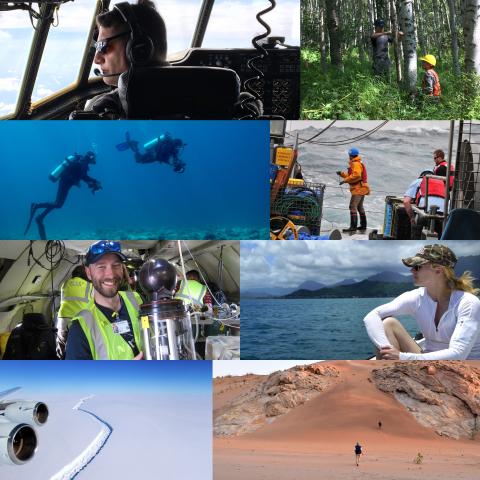New developments in sunphotometry, left, prototype SEASTAR (SEAgoing Sky-scanning, sun-Tracking Atmospheric research Radiometer) for ship-based deployment of sunphotometers, center, 4STAR-B (Spectrometers for Sky-Scanning Sun Tracking Atmospheric Research - B), right, ground prototype with newly developped multi-decade radiometers for 5STAR (ultra-Stable Spectrometers for Sky-Scanning Sun Tracking Atmospheric Research), far right, Dr. Steve Broccardo, NASA Post-doctoral Program Fellow.
News
Fleet in development

4STAR team on successful ORACLES 2018 deployment

4STAR was deployed on the NASA P3 during ORACLES 2018 based out of Sao Tomé. Here our team kept 4STAR operating great for the whole deployment.
Roy presenting new concept idea of SEASTAR at Ames Innovation Fair

Roy is leading and presenting a new concept for a shipborne automated sunphtometer and sky radiance collector, SEASTAR, at the NASA Ames Research Center's annual innovation fair. Here he is demonstrating the use of a handheld sunphotometer 'microtops' to a group of NASA Ames colleagues.
New partners with NRC Canada - 4STAR integrated onto the Convair 580
We formed a new partnership with the Canadian National Research Council. We sucessfully integrated 4STAR onto their Convair 580, for sampling during a Canadian Oil Sands project.
Calibrating away at Mauna Loa Observatory

4STAR, 4STARB, and AATS are standing tall at the Maun Loa Observatory, at 11000 ft altitude within the remote Pacific Atmosphere, where the nearly pristine environment, with low aerosol optical depth, is used for calibrating our measurements.
4STARB's first flight campaign successful!

Yohei holding 4STARB in the NASA C130 cockpit getting ready for a daily install. This was 4STARB's first flight campaign, as part of the 3rd deployment of NAAMES based out of St-John's, Newfoundland, Canada.
Connor and Jens awaiting the P3 in Sao Tome

From our PNNL collaborators: Schmid, Flynn Continue Longtime Partnership with NASA on Unique Atmospheric Instrumentation

Pacific Northwest National Laboratory highlighted the continued fruitful collaboration of Drs. Beat Schmid and Connor Flynn with NASA Ames Research Center' Sunphotometer Satellite Group.
http://www.pnnl.gov/science/highlights/highlight.asp?id=4615&groupid=749
4STAR work identified in next year's Earth Science field work

4STAR scientist and field missions are showcased in a news article:
NASA scientists are crisscrossing the globe in 2017 – from a Hawaiian volcano to Colorado mountain tops and west Pacific islands – to investigate critical scientific questions about how our planet is changing and what impacts humans are having on it.
4STAR watching the sun rise in Namibia
4STAR sitting on top of the NASA P3 is watching the sun rise from Africa. It was getting ready for the first of many coordinated flights with the NASA P3 and ER2.
ORACLES sampled biomass burning aerosol above clouds with the use of 4STAR
ORACLES is now operating in Namibia. 4STAR integrated on the NASA P3 sampled the thick biomass burning aerosol layer over clouds in the South East Atlantic.
4STAR is on the P3!

4STAR is ready for ORACLES! It was integrated on board the NASA P-3 in Wallops Flight Facility, amidts a heat wave and large musquitos.
2STAR: Newest member of the sunphotometer family
We have been working towards a ground based detector standard to help link 4STAR measurements from the air to a stable ground source. This is the 2STAR, Spectrometer for Sun-Tracking Atmospheric Research.
Visiting Korea with 4STAR

The NASA DC-8 hosts many instruments during the KORUS-AQ field mission to Korea. Here we see the plethora of inlets protruding from the window plates. But none stands as proud as the 4STAR ball in the zenith port, tracking the sun through South Korea's haze.
Comparing airborne and ground based sunphotometer in Korea

The DC8 parked on the tarmac during the KORUS-AQ mission. This is a great opportunity to compare measurements from our airborne sunphotometer, 4STAR, to that of the ground based sunphotometer, Prede. They are both performing admirably in this hazy environment.
Roof top measurements at Ames in preperation for KORUS-AQ and NAAMES

In preperation for our upcoming field deployments for KORUS-AQ and the second phase of NAAMES, we have been very busy testing and calibrating our instruments. 4STAR and AATS-14 are now ready to be deployed after these roof top tests at NASA Ames Research Center.
Staring at the sun: MLO calibrations of sunphotometers

We recently did a trip to Mauna Loa in efforts to calibrate our sunphotometers. Here we see the 4STAR tracking the sun along side its predecessor AATS, and the ground based Prede. The Mauna Loa Observatory (MLO) is chosen for this event because of it's high altitude, and remoteness (middle of the Pacific Ocean).
North Atlantic in November, NAAMES C130 view

The first part of NAAMES mission brought us to sample over the North Atlantic in November. Based out of St-John's Newfoundland, Canada, the C130 routinely took flights of 10 hours to the middle of the Atlantic Ocean. It's a view seldom seen from a commercial airliner.


